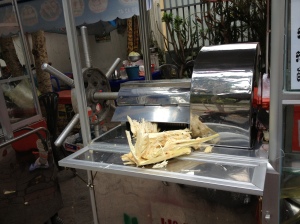Bicycling in the streets of phnom penh, one can sense so much similarity to southern indian places. Being a foodie, my eyes and interest obviously stick to those things I value primary. Like the vegetable market especially… loaded with tropical stuff, even some of those rare fruits amd vegetables that have been our childhood nibblers!
I have tried to capture some… let us enjoy it together!
I gave the title ‘The Cambodia Connections’ and also suffixed with ‘I’. There is an ocean of many more things that would follow in future posts, that could be categorised under the same title.
Kothumalli/Coriander
Kothumalli/Coriander is available in plenty. But more than the green, fresh coriander, what attracts the most is the way it has been clipped beautifully with the cut palm leaf or something else I am yet to find out! We call it Kothumalli Kattu is Tamil – it means tied coriander bunch.
the beautiful bunch

Nellikkai/Gooseberry
Nellikkai/Gooseberry is one of those summer delights which is a sour fruit and when one has a glass of water after, it sweetens ones taste buds.
The health benefits of gooseberry –
enhances food absorption, balances stomach acid, fortifies the liver, nourishes the brain and mental functioning, supports the heart, strengthens the lungs, regulates elimination, enhances fertility, helps the urinary system, is good for the skin, promotes healthier hair, acts as a body coolant, flushes out toxins, increases vitality, strengthens the eyes, improves muscle tone and it acts as an antioxidant. http://www.organicfacts.net/health-benefits/fruit/health-benefits-of-indian-gooseberry-or-amla.html
While Nellikkai is available in the markets and vendors in bicycles – the packet of salt and red chilli powder that comes with the pack made me feel at home truly….. that’s the way we have our raw fruits like mangoes, guavas and gooseberries.
nellikkai with salt and chilli

Kodukkapuli
also known as – Guamachil, Manila Tamarind, Kodukkai Puli/Kodi-kai puli, Sweet Tamarind, Thai-Sweet Tamarind, Madras Thorn, Monkey Pod, Jungle Jilebi, Bilayati Imli, Seema Chintakayalu (Foreign Tamarind), Kona Puliyankai (Twisted Tamarind) http://www.flickr.com/photos/babishvb/5512545340/ –
Now, I had been searching this for a long time… in Chennai whenever I go on a holiday. But not been able to find it. This used to be one of our childhood nibblers (if I could call them so) sold out of the school in Thoothukudi. Myself and my cousin who used to come out of school would buy kodukkappalli and nellikkai and munch back home! It is called Kodukkapuli in Tamil and we used to call it kodukkappalli colloquially.
The sweet soury taste still lingers in my tongue.. with some sweet memories too!
the twisted tamarind

I could find some interesting facts on this fruit from http://www.flickr.com/photos/babishvb/5512545340/ –
Kodukka puli came from the word Kodi-Kai puli which means Vined Tamarind
* peel the black seeds to reveal a brown coating (not the white ‘main’seed inside) and then string them into bracelets
* The pod/pulp is widely used in the tanning industry. Camachile bark used almost exclusively by Filipino tanners
* Used as good timber
* Mucilaginous gum
* Used for preparing yellow dye
The Manila tamarind fruit is low in calories, and including it in your diet can help you meet your daily fiber, vitamin C, iron, calcium and potassium needs.
It promotes normal bowel movements, controls hunger and lowers your risk of heart disease.
It is also an important antioxidant, protecting your cells from free radicals, which can help reduce your risk of heart disease and cancer. http://www.livestrong.com/article/497683-the-nutritional-value-of-manila-tamarinds/
Thengai/Coconut
The south of India uses more coconut in cooking. Buying coconut and grating in not a problem anymore. In the market, you choose your coconut and the vendor grates it in front of you. It looks like an indigenous coconut grating machine made from local items.. very interesting!
the machine

coconuts grated

Karumbu Chaaru/Sugarcane Juice
On a humid, sunny, sweaty day, a glass of sugarcane juice can provide instant energy. Karumbu Chaaru in Tamil. Karumbu is sugarcane and Chaaru means juice. In the streets of Phnom Penh, one can find these small carts/machines and the juice is sold in disposable glasses… covered in a small plastic bag – easy to be hung in cycle handlebars or be placed in water bottle holders in bags. There are also halves of lemon squeezed between the canes while they are being pressed… I think in India, it is also a bit of ginger added while the juice is pressed…if I am right.
The only problem is the glass would first be filled with icecubes it can fully hold and the other approximately 3 or 4 ladles of juice would fill the glass… great chiller ofcourse but solely due to ice. Pay double or triple and you get the same glass full of juice… but my sugarcane lady is very friendly though.. she insists I take ice in the outer bag and she places the closed full juice glass in the ice bag and we reach home with undiluted ice cold karumbu chaaru/sugarcane juice!
the machine

stored sugarcanes and the juice

It is truly a warm feeling of being at home! An exploration of more cultural and cuisinical similarities between the Tamils and the Khmers! I shall try my best!
It is Tamil Puthaandu/Tamil New Year on April the 14th. The Khmer New Year called Chaul Chnam Thmey (means Enter New Year) is celebrated for 3 days starting April 13 to April 15.
Puthaandu Vazhthukkal! Happy New Year!
Suo Sdey Chnam Thmey!!

































